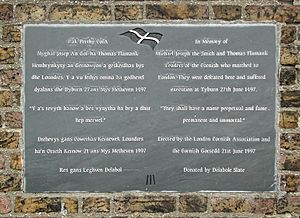Michael An Gof facts for kids
Michael Joseph, known as Michael An Gof, was an important leader in the Cornish Rebellion of 1497. He was a blacksmith from Cornwall. Along with Thomas Flamank, a lawyer, he led thousands of Cornish people to protest against King Henry VII. They marched all the way to London to share their concerns with the King.
Contents
Why the Cornish Rebelled
In 1497, King Henry VII wanted to raise money for a war. He planned to invade Scotland because the Scots were supporting someone named Perkin Warbeck. Warbeck claimed to be a prince who should be king. To pay for this war, King Henry VII decided to collect a new tax from his people.
The people of Cornwall felt this tax was unfair. They believed the war with Scotland was a problem for the northern parts of England, not for them. They also thought the King's advisors were tricking him into collecting this tax. So, they decided to march to London to tell the King their feelings.
The March to London
Michael Joseph, a blacksmith from a village called St Keverne in Cornwall, became a key leader. People described him as someone who spoke up often and loudly against the government. Because of this, he gained trust among the local people. He was ready to lead them in a big protest.
The people of St Keverne chose Michael Joseph to challenge the new tax. As he and his followers marched, they reached a town called Bodmin. There, they were joined by Thomas Flamank, who was a lawyer from the area.
Flamank explained that defending the border with Scotland was usually the job of the noble families in the north. He argued that the new tax was not legal. He suggested that the Cornish people should march to London. Their goal was to give a petition to the King. This petition would explain their complaints about the King's advisors.
Under the leadership of Flamank and Joseph, about 6,000 Cornish people gathered in Bodmin. They began their long march. As they traveled, more people joined them, and they received food and supplies. By the time they reached Devon, their army had grown to about 15,000 people.
Most of the march had been peaceful. However, when they arrived in Taunton, a town in Somerset, something went wrong. An officer named Provost Perrin, who was collecting the tax, was killed.
The rebels hoped to get support from people in Kent, a county closer to London. This area had seen a big rebellion before, led by Jack Cade in 1450. The Cornish rebels even went to Blackheath, a place where Cade's rebellion had gathered. But sadly, they did not get much help there.
The Battle and Its Aftermath
The King's army met the Cornish rebels at the Battle of Deptford Bridge. This battle happened on June 17, 1497, near the River Ravensbourne. The King's forces were stronger and defeated the Cornish rebels.
After the battle, Michael Joseph tried to escape to Greenwich. But he was caught and taken to the Tower of London.
As one of the main leaders, Michael An Gof was put to death along with Thomas Flamank on June 27, 1497. Before his execution, An Gof was heard to say that he would have "a name perpetual and a fame permanent and immortal." This meant he believed his name and actions would be remembered forever.
In 1997, 500 years after the rebellion, a special march was held. It was called "Keskerdh Kernow 500." People walked the same route from St Keverne, An Gof's hometown, all the way to London. A statue of An Gof and Flamank was revealed in St Keverne. Also, a special plaque was placed on the wall of Greenwich Park, facing Blackheath common.
The Name "An Gof"
The name "An Gof" comes from the Cornish language. It means "the blacksmith." This name is the origin of the British surname Angove. Other similar names include "Gow" and "Gowan," and the Irish or Scottish name "McGowan."
The Holyer An Gof trophy is a yearly award. It is given for the best book or publication about Cornwall. This award is part of the Cornish Gorsedd, which celebrates Cornish culture.
"An Gof" was also the name of a rock band. They performed a song on an album called Keltia Rok in 1987.
See also
- List of topics related to Cornwall
- Second Cornish Uprising of 1497
- Prayer Book Rebellion
- The Wikipedia Cornwall Portal


